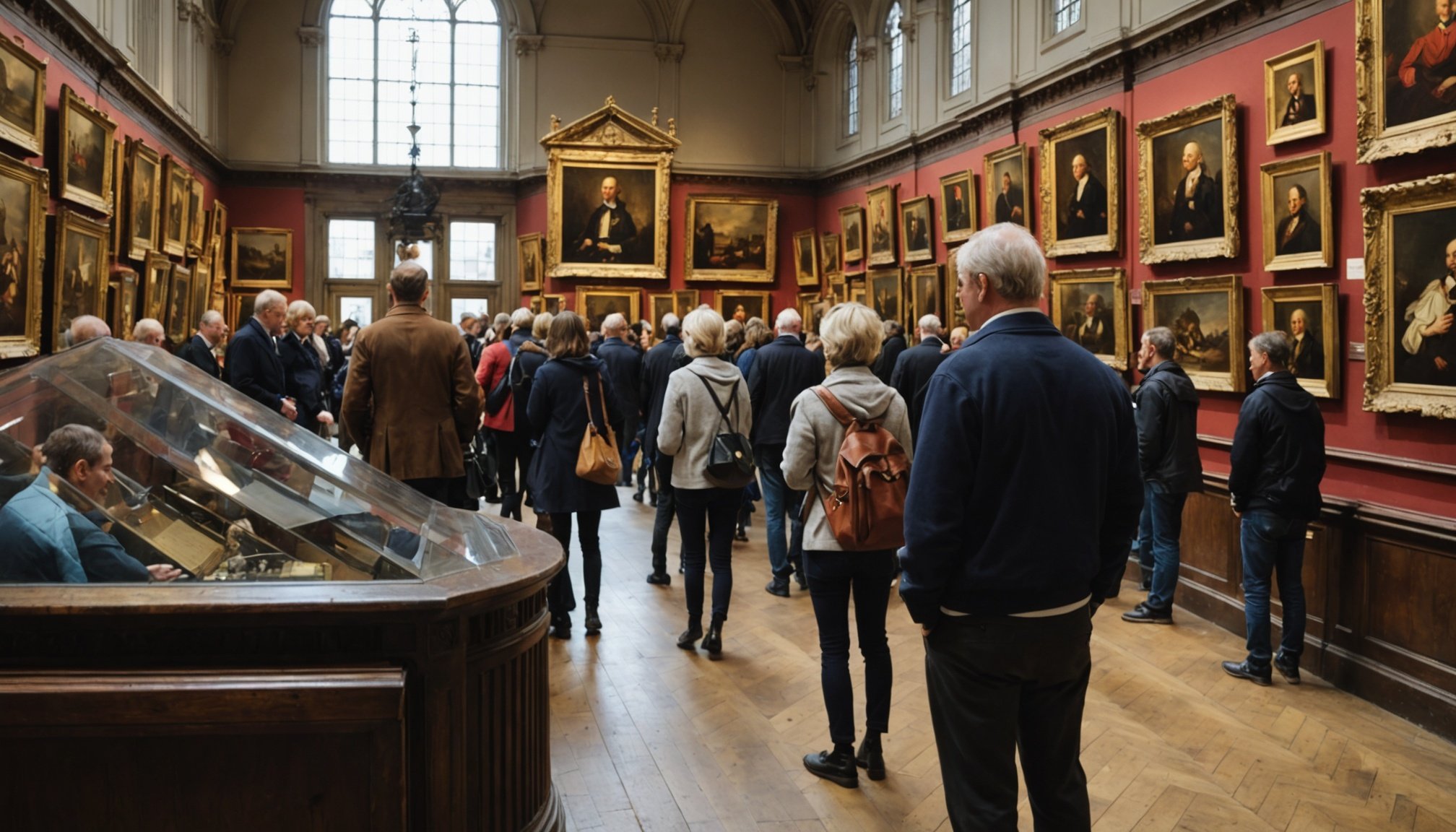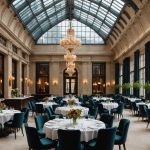Understanding Visitor Engagement in Museums
Visitor engagement is a pivotal concept that determines how effectively UK museums captivate and educate their audiences. It refers to the interactions between visitors and the museum, its collections, and its offerings. Vital for enhancing experiences, visitor engagement is linked to increased visitor retention and satisfaction.
The importance of engagement is underscored by its influence on a museum’s reputation and financial health. Engaged visitors tend to spend more time and money, often becoming loyal patrons. As museums aim to remain relevant and accessible, understanding and improving engagement is essential.
This might interest you : Boosting Performance: Innovative Distribution Tactics for UK Breweries
Key metrics for measuring engagement effectively include visitor dwell time, repeat visits, and interactivity with exhibits. Surveys and feedback forms provide insights into visitor satisfaction and preferences. By analysing these metrics, museums can tailor exhibits and activities to better meet visitor expectations, enhancing the overall experience.
Engagement significantly impacts visitor retention. Museums that offer immersive, interactive experiences encourage repeat visits, fostering a sense of community and belonging. Exhibition content that is relatable and engaging helps maintain interest, ensuring visitors feel satisfied and valued.
Also read : Mastering influencer marketing for uk fashion brands: the definitive guide to success
In summary, focusing on visitor engagement is a strategic priority for UK museums. By measuring and enhancing engagement, museums can thrive, offering enriching experiences that resonate with their audiences.
Tactic 1: Enhancing Digital Presence
In the digital era, a museum’s digital marketing strategy is crucial, especially to captivate audiences who predominantly engage online. A user-friendly museum website plays a pivotal role in information dissemination, offering essential data like exhibition details, opening hours, and visitor information effortlessly. Such convenience encourages users to delve deeper into the museum’s offerings, impacting overall visitor engagement.
There’s a growing trend of museums leveraging online engagement platforms to build relationships with potential visitors, primarily through social media channels. These platforms allow museums to showcase collections, share insights, and create a community around their brand. For instance, engaging content such as virtual tours or interactive posts captivate audiences, fostering a sense of belonging and interest even before the museum is physically visited.
Several UK museums exemplify success in this realm; for instance, the British Museum has effectively employed digital marketing strategies. By dynamically employing their website and social media, they’ve increased visibility and interaction, setting a precedence for others. By focusing on online engagement, museums can transcend geographic constraints, reaching a broader audience base. Thus, prioritizing digital presence becomes not just beneficial but essential.
Tactic 2: Interactive Exhibitions
Interactive exhibits are revolutionising museum experiences by fostering visitor participation through engaging interactive displays. These exhibitions invite participants to not only observe but to become a part of the exhibit itself. This integration allows museums to transform passive observation into an active learning process.
Incorporating interactive elements in exhibit design serves multiple benefits. Firstly, it enhances visitor engagement, creating memorable experiences that resonate both intellectually and emotionally. Interactive displays encourage curiosity and exploration, promoting a deeper understanding of the subject matter. Such features can cater to diverse audiences, spanning all age groups and learning preferences.
Numerous UK museums have successfully embraced this tactic. Take, for instance, the Science Museum in London, which uses compelling technology to allow visitors to explore scientific phenomena in hands-on ways. The Natural History Museum employs augmented reality to bring extinct creatures to life, allowing visitors an unprecedented level of interaction.
When it comes to designing these engaging, hands-on experiences, consider incorporating sensory elements such as touch screens and audio guides. Personalisation is key—offering choices or roles within the exhibit can increase involvement. Moreover, feedback mechanisms where visitors can share insights or reactions can enhance the overall experience. This approach ensures that exhibits remain dynamic and impactful, continually drawing visitors back for more insightful interactions.
Tactic 3: Community Collaboration
Fostering community engagement is essential for museums aiming to create meaningful connections and lasting impacts. By forming partnerships with local organizations and artists, museums can tap into a wealth of creativity and resources. Engaging with local artisans can enhance exhibitions and bring fresh, culturally-relevant perspectives.
One effective strategy is to co-create community-driven events. Collaborating on art projects, workshops, or exhibitions allows the community to feel invested in the museum’s success. These programs not only attract diverse audiences but also encourage active local involvement. For instance, museums might host ‘community days’ where members of the community are invited to contribute their stories or art, building a sense of ownership and pride.
Success stories abound. Consider the approach of a museum that partnered with a local youth group to create a mural. This project not only beautified the museum space but also engaged the youth, fostering a sense of belonging and respect for the institution. Similarly, collaborations with local craftsmen for exhibitions have provided platforms for artisans to showcase their work, benefiting both parties and enriching the cultural landscape.
Such collaborative efforts enhance not just the museum experience but the community as a whole, ensuring that both thrive through mutual support and shared success.
Tactic 4: Personalized Visitor Experiences
To boost visitor satisfaction, tailoring experiences to individual needs is paramount. Personalization in visitor experiences can transform mundane visits into captivating journeys. Imagine a family with young children exploring a museum: their experience can be tailored to include interactive exhibits and storytelling catered to their age, enhancing engagement and satisfaction.
Technologies and tools like apps, augmented reality tours, and interactive kiosks are pivotal in customizing visits. Many UK museums have embraced these innovative tools. For instance, some museums use mobile apps that allow visitors to choose tailored routes based on their interests. Through this, each visitor receives a personalized experience, ensuring their visit is as enriching and enjoyable as possible.
Several museums utilize visitor data to create tailored programs, adapting their exhibitions based on popular interest metrics. As a part of personalized services, these institutions offer themed experiences, special guided tours, and even bespoke souvenir options to commemorate the visit uniquely.
By prioritizing personalization, museums not only enhance visitor contentment but also foster a deeper connection between their exhibits and the audience. Ultimately, providing a tailored visitor experience is an effective strategy in ensuring repeat visits and cultivating a loyal visitor base.
Tactic 5: Educational Workshops and Programs
Enhancing audience engagement through educational workshops and learning programs is a strategic approach embraced by UK museums. Such programs play a significant role in attracting diverse audiences by offering engaging and informative experiences. Educational engagement initiatives often include hands-on activities, discussions, and interactive sessions, all aimed at making learning enjoyable and meaningful.
Successful examples from UK museums illustrate the potential of well-crafted learning programs. For instance, workshops focusing on historical reenactments or scientific experiments have proven successful in captivating both young learners and adults. These sessions typically incorporate technology to offer immersive experiences, ensuring participants leave with increased knowledge and a positive impression of the museum.
In developing impactful educational offerings, it is crucial to tailor content to the audience’s interests and needs. Strategies include setting clear educational objectives, collaborating with educational experts, and evaluating previous programs for continuous improvement.
Moreover, offering variety in themes and formats can cater to different learning preferences, whether through storytelling sessions, creative arts workshops, or STEM-focused modules. Ensuring accessibility for all demographic groups can further broaden the reach and impact of these programs, making museums a hub of lifelong learning.
Educational workshops and learning programs are essential in fostering an engaged, knowledgeable audience, contributing significantly to a museum’s lasting success.
Tactic 6: Leveraging Visitor Feedback
Gathering visitor feedback is crucial in understanding audience preferences and expectations. Engaging with your audience through surveys allows museums to capture valuable insights. This form of audience analysis can direct future strategies and enhance visitor experiences significantly.
Incorporating regular feedback mechanisms, like on-site survey kiosks or online feedback forms, provides ongoing insights into visitor satisfaction and areas needing improvement. The data collected through these surveys help museums to not only address immediate concerns but also to plan long-term enhancements. For instance, if multiple attendees note that exhibit descriptions are difficult to read, adjustments can swiftly be made.
Feedback should not only focus on criticism. Positive insights can highlight which exhibits or programs resonate well with audiences, steering museums towards successful content. An effective survey will cover all aspects, from logistics to content engagement, ensuring a comprehensive overview of the visitor experience.
Consider The Art Institute of Chicago, which utilized visitor feedback to revamp its exhibit routes, resulting in improved visitor flow and satisfaction. By acting on survey responses, museums can evolve, proving to future visitors that their opinions genuinely shape their experiences.
Ultimately, audience analysis fosters an inclusive dialogue between institutions and visitors, promoting continuous improvement and engagement.
Tactic 7: Innovative Marketing Strategies
Museums today are exploring new marketing tactics to boost visitor numbers and engagement. Successfully identifying and targeting specific visitor demographics is fundamental to these efforts. By understanding the unique preferences and interests of their audience, museums can tailor their messaging and exhibits to attract a more diverse crowd.
Innovative Promotional Campaigns
In recent years, some innovative promotional campaigns have made waves by driving significant engagement. Examples include interactive social media challenges that encourage audience participation and collaborations with influencers who can reach broader demographics. These strategies not only appeal to tech-savvy visitors but also position museums as accessible and modern cultural hubs.
Resources for Enhanced Strategies
To further strengthen their marketing tactics, museums can utilize available resources designed to enhance audience outreach. Digital platforms such as targeted email campaigns or data analytics tools provide insights into visitor behaviour, allowing museums to refine their approaches. Additionally, partnerships with local businesses or cultural organizations can expand reach and attract new visitors.
By adopting these innovative strategies, museums not only attract new audiences but also deepen relationships with existing visitors. These efforts highlight the importance of adapting to changing visitor expectations and embracing new avenues for promotional success in the cultural sector.
Tactic 8: Virtual Tours and Augmented Reality
The rise of virtual tours has revolutionised how the world accesses cultural experiences and historical sites. Now more than ever, technological engagement allows museums to transcend physical barriers, providing access to those who might not otherwise have the opportunity to explore these rich resources. Virtual tours enable users to navigate spaces with a 360-degree view from any device, anywhere, at any time.
Augmented reality (AR) technology significantly enhances visitor experiences by overlaying digital information onto the physical world. This innovative approach not only heightens engagement but also enriches learning opportunities. AR can transform a simple exhibit into an interactive story, making history tangible and exciting.
In the UK, numerous museums are creatively using these technologies. For instance, the British Museum offers virtual tours of their galleries, allowing global audiences to witness their exquisite collections. Meanwhile, the Science Museum in London uses AR to animate exhibits, fostering a deeper understanding of scientific principles among visitors.
These cutting-edge advancements demonstrate that virtual tours and augmented reality are not just trends but essential tools for engaging today’s tech-savvy audiences. As more institutions adopt these solutions, the potential for broader accessibility and enhanced educational experiences continues to grow, reshaping how we experience culture and history.
Tactic 9: Engaging Social Media Content
Creating engaging social media content is essential for effective social media marketing and enhancing audience engagement. To achieve this, museums must craft a well-considered content strategy. This includes incorporating compelling narratives that resonate with their audience. A key element is storytelling, which bridges the gap between the museum’s offerings and the audience’s interests.
Employing storytelling within social media strategies can significantly boost engagement levels. It transforms simple posts into captivating narratives that draw users in. Museums can share stories about their exhibits, artifacts, or the histories of the artists involved. A narrative-driven content strategy not only captivates but also encourages audiences to interact, share, and comment, building a stronger community.
Several UK museums have demonstrated success through innovative social media campaigns. For instance, the British Museum connected with its audience by sharing artifact stories, drawing international interest and engagement. Similarly, the Museum of London leveraged current events, linking their exhibits to present-day stories, creating a relatable and engaging narrative for their audience. These examples highlight how an effective content strategy powered by storytelling can turn simple posts into a dialogue, enhancing both reach and engagement.
By focusing on best practices and leveraging storytelling, museums can achieve impactful social media marketing results, fostering lasting connections with their audience.
Tactic 10: Hosting Special Events and Exhibitions
Museums in the UK have increasingly turned to special events and temporary exhibitions as powerful tools to attract broader audiences. These events significantly boost visitor numbers by offering unique experiences that aren’t available in the regular exhibit repertoire. Special events, such as Night at the Museum themed evenings or interactive art installations, not only draw regular museum-goers but also entice those who might not typically visit.
With numerous examples of successful events, the Natural History Museum’s Dino Snores and the V&A’s Friday Late stand out. These events manage to intrigue diverse age groups and interests, creating a buzz that extends beyond regular museum borders.
Planning a high-impact event involves a strategic approach that encompasses everything from concept development to post-event analysis. Key strategies for planning include identifying specific audience segments, ensuring the content aligns with audience interests, and creating interactive elements that engage visitors actively. Effective promotion is vital, utilizing multiple platforms, from social media to local advertising, to generate excitement leading up to the event. Collaborations with influencers and community leaders can also amplify reach and impact.
Ultimately, the integration of special events into a museum’s calendar can transform it from a static venue to a dynamic cultural hub.











